Summarizing and Critiquing James Davies' Difficult Behavior Report
VerifiedAdded on 2022/09/26
|7
|2232
|21
Report
AI Summary
This report provides a detailed analysis of James Davies, a child diagnosed with autism, focusing on his challenging behaviors at school and home. The report synthesizes information from observations, teacher referrals, and Mrs. Davies' interview to understand the nature and frequency of James' behaviors, including avoidance of communication, rigid tendencies, and outbursts. It explores the impact of his autism on his interactions, particularly his selective communication and resistance to tasks. The report also considers the family dynamics, highlighting the challenges faced by the parents and the need for tailored support. It critiques the observed behaviors, providing recommendations for interventions such as psychological therapy, parental adjustments, and school-based strategies. The report emphasizes the importance of patience, understanding, and a focus on James' interests to facilitate his development and integration.
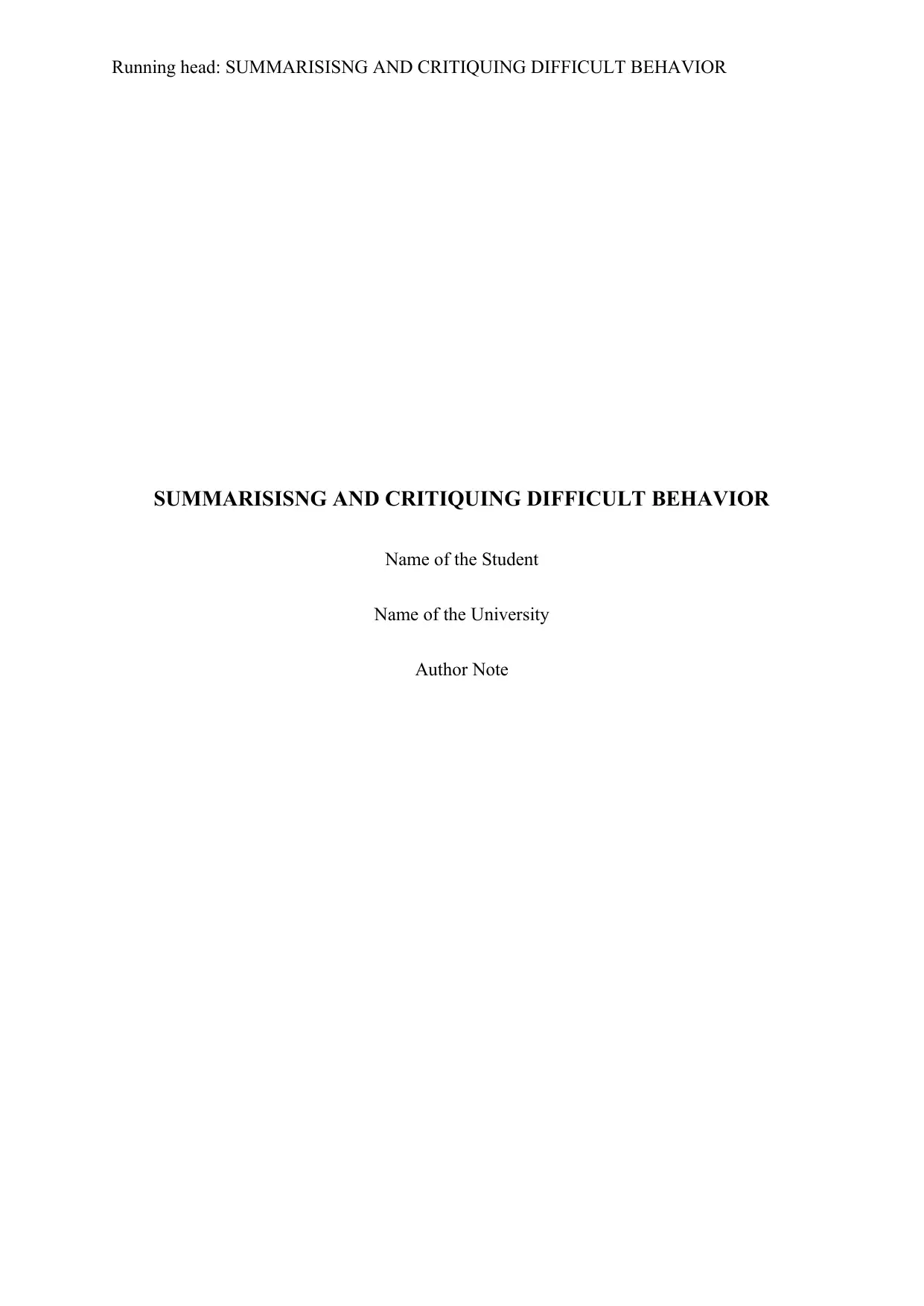
Running head: SUMMARISISNG AND CRITIQUING DIFFICULT BEHAVIOR
SUMMARISISNG AND CRITIQUING DIFFICULT BEHAVIOR
Name of the Student
Name of the University
Author Note
SUMMARISISNG AND CRITIQUING DIFFICULT BEHAVIOR
Name of the Student
Name of the University
Author Note
Paraphrase This Document
Need a fresh take? Get an instant paraphrase of this document with our AI Paraphraser
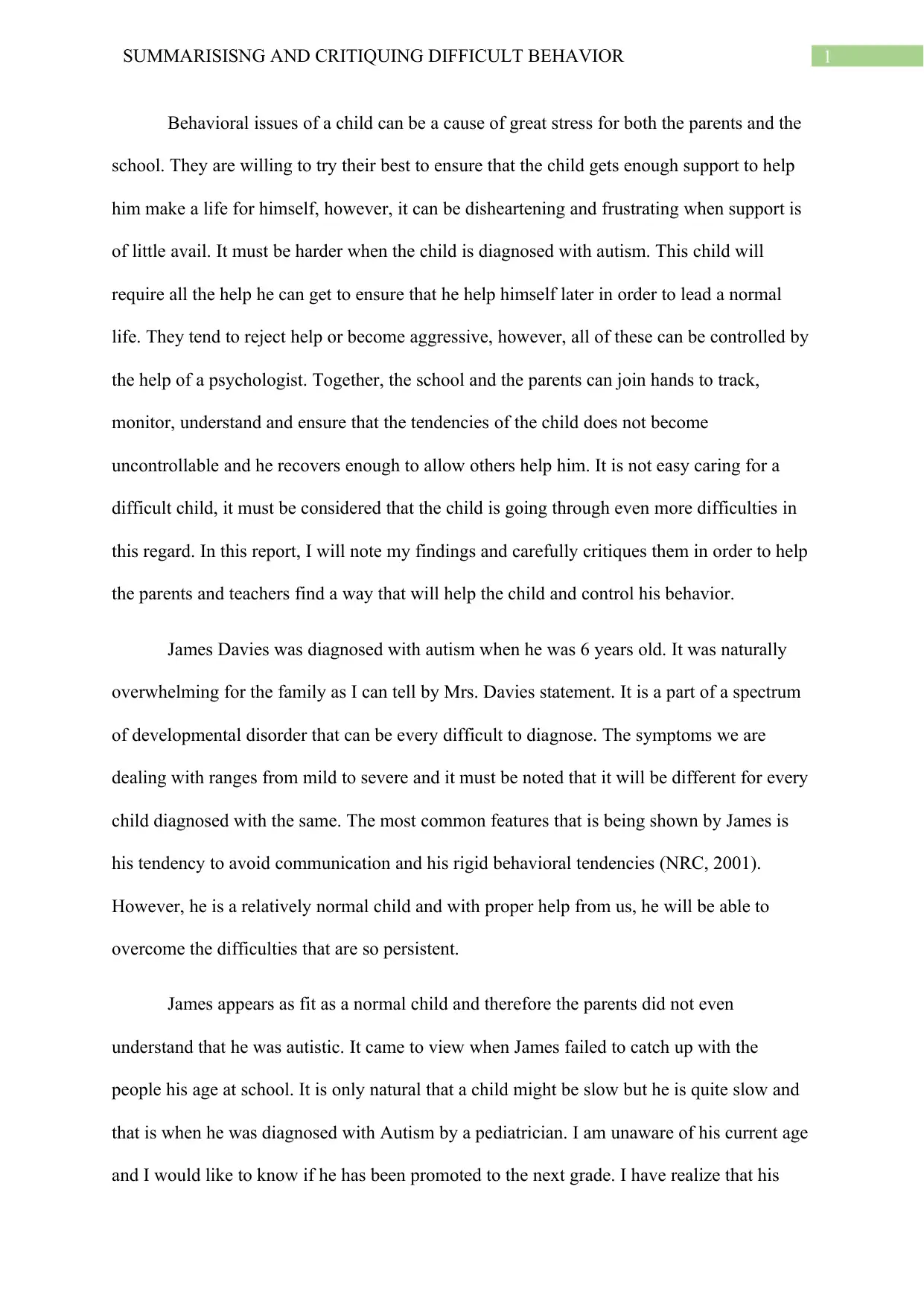
1SUMMARISISNG AND CRITIQUING DIFFICULT BEHAVIOR
Behavioral issues of a child can be a cause of great stress for both the parents and the
school. They are willing to try their best to ensure that the child gets enough support to help
him make a life for himself, however, it can be disheartening and frustrating when support is
of little avail. It must be harder when the child is diagnosed with autism. This child will
require all the help he can get to ensure that he help himself later in order to lead a normal
life. They tend to reject help or become aggressive, however, all of these can be controlled by
the help of a psychologist. Together, the school and the parents can join hands to track,
monitor, understand and ensure that the tendencies of the child does not become
uncontrollable and he recovers enough to allow others help him. It is not easy caring for a
difficult child, it must be considered that the child is going through even more difficulties in
this regard. In this report, I will note my findings and carefully critiques them in order to help
the parents and teachers find a way that will help the child and control his behavior.
James Davies was diagnosed with autism when he was 6 years old. It was naturally
overwhelming for the family as I can tell by Mrs. Davies statement. It is a part of a spectrum
of developmental disorder that can be every difficult to diagnose. The symptoms we are
dealing with ranges from mild to severe and it must be noted that it will be different for every
child diagnosed with the same. The most common features that is being shown by James is
his tendency to avoid communication and his rigid behavioral tendencies (NRC, 2001).
However, he is a relatively normal child and with proper help from us, he will be able to
overcome the difficulties that are so persistent.
James appears as fit as a normal child and therefore the parents did not even
understand that he was autistic. It came to view when James failed to catch up with the
people his age at school. It is only natural that a child might be slow but he is quite slow and
that is when he was diagnosed with Autism by a pediatrician. I am unaware of his current age
and I would like to know if he has been promoted to the next grade. I have realize that his
Behavioral issues of a child can be a cause of great stress for both the parents and the
school. They are willing to try their best to ensure that the child gets enough support to help
him make a life for himself, however, it can be disheartening and frustrating when support is
of little avail. It must be harder when the child is diagnosed with autism. This child will
require all the help he can get to ensure that he help himself later in order to lead a normal
life. They tend to reject help or become aggressive, however, all of these can be controlled by
the help of a psychologist. Together, the school and the parents can join hands to track,
monitor, understand and ensure that the tendencies of the child does not become
uncontrollable and he recovers enough to allow others help him. It is not easy caring for a
difficult child, it must be considered that the child is going through even more difficulties in
this regard. In this report, I will note my findings and carefully critiques them in order to help
the parents and teachers find a way that will help the child and control his behavior.
James Davies was diagnosed with autism when he was 6 years old. It was naturally
overwhelming for the family as I can tell by Mrs. Davies statement. It is a part of a spectrum
of developmental disorder that can be every difficult to diagnose. The symptoms we are
dealing with ranges from mild to severe and it must be noted that it will be different for every
child diagnosed with the same. The most common features that is being shown by James is
his tendency to avoid communication and his rigid behavioral tendencies (NRC, 2001).
However, he is a relatively normal child and with proper help from us, he will be able to
overcome the difficulties that are so persistent.
James appears as fit as a normal child and therefore the parents did not even
understand that he was autistic. It came to view when James failed to catch up with the
people his age at school. It is only natural that a child might be slow but he is quite slow and
that is when he was diagnosed with Autism by a pediatrician. I am unaware of his current age
and I would like to know if he has been promoted to the next grade. I have realize that his
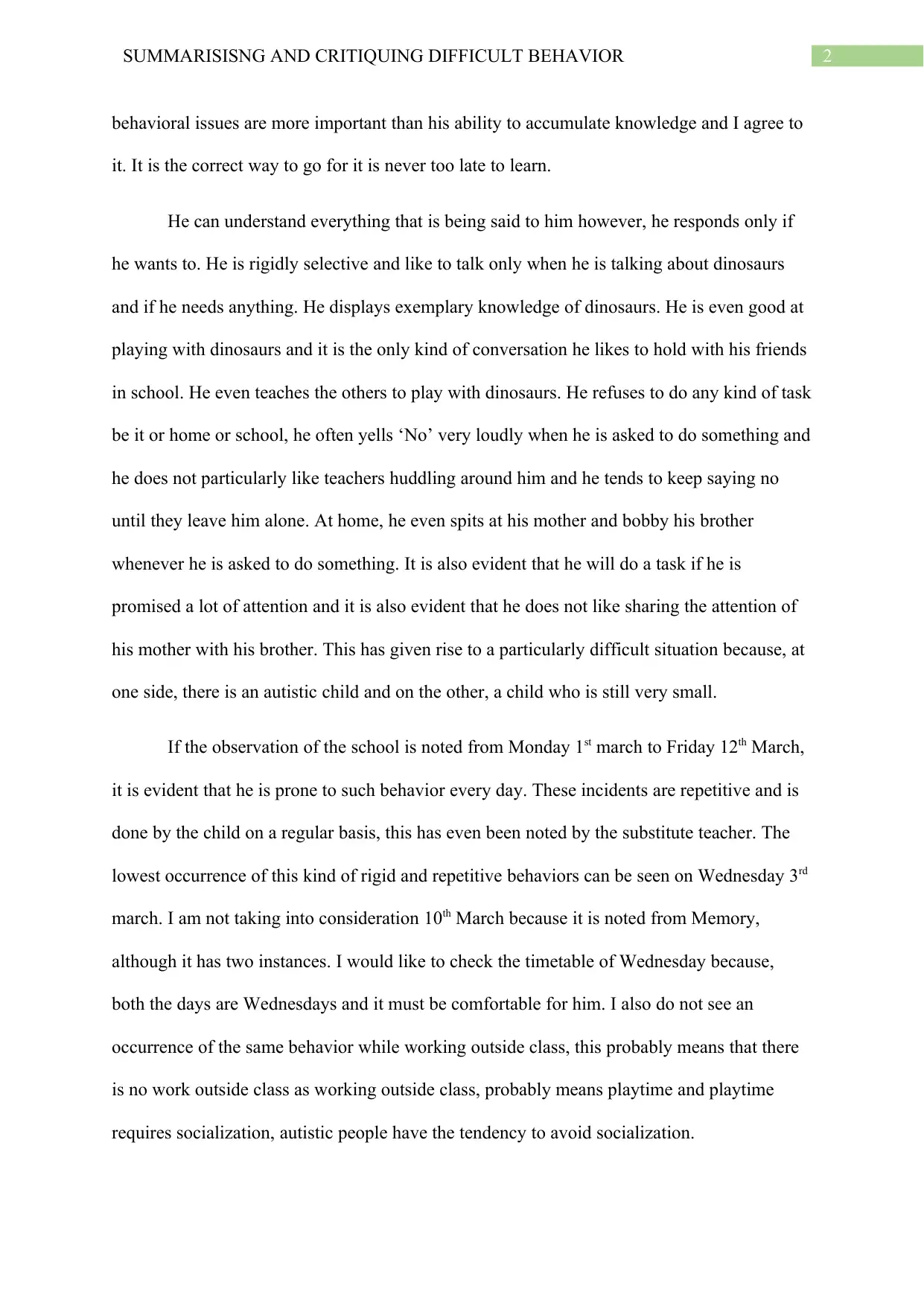
2SUMMARISISNG AND CRITIQUING DIFFICULT BEHAVIOR
behavioral issues are more important than his ability to accumulate knowledge and I agree to
it. It is the correct way to go for it is never too late to learn.
He can understand everything that is being said to him however, he responds only if
he wants to. He is rigidly selective and like to talk only when he is talking about dinosaurs
and if he needs anything. He displays exemplary knowledge of dinosaurs. He is even good at
playing with dinosaurs and it is the only kind of conversation he likes to hold with his friends
in school. He even teaches the others to play with dinosaurs. He refuses to do any kind of task
be it or home or school, he often yells ‘No’ very loudly when he is asked to do something and
he does not particularly like teachers huddling around him and he tends to keep saying no
until they leave him alone. At home, he even spits at his mother and bobby his brother
whenever he is asked to do something. It is also evident that he will do a task if he is
promised a lot of attention and it is also evident that he does not like sharing the attention of
his mother with his brother. This has given rise to a particularly difficult situation because, at
one side, there is an autistic child and on the other, a child who is still very small.
If the observation of the school is noted from Monday 1st march to Friday 12th March,
it is evident that he is prone to such behavior every day. These incidents are repetitive and is
done by the child on a regular basis, this has even been noted by the substitute teacher. The
lowest occurrence of this kind of rigid and repetitive behaviors can be seen on Wednesday 3rd
march. I am not taking into consideration 10th March because it is noted from Memory,
although it has two instances. I would like to check the timetable of Wednesday because,
both the days are Wednesdays and it must be comfortable for him. I also do not see an
occurrence of the same behavior while working outside class, this probably means that there
is no work outside class as working outside class, probably means playtime and playtime
requires socialization, autistic people have the tendency to avoid socialization.
behavioral issues are more important than his ability to accumulate knowledge and I agree to
it. It is the correct way to go for it is never too late to learn.
He can understand everything that is being said to him however, he responds only if
he wants to. He is rigidly selective and like to talk only when he is talking about dinosaurs
and if he needs anything. He displays exemplary knowledge of dinosaurs. He is even good at
playing with dinosaurs and it is the only kind of conversation he likes to hold with his friends
in school. He even teaches the others to play with dinosaurs. He refuses to do any kind of task
be it or home or school, he often yells ‘No’ very loudly when he is asked to do something and
he does not particularly like teachers huddling around him and he tends to keep saying no
until they leave him alone. At home, he even spits at his mother and bobby his brother
whenever he is asked to do something. It is also evident that he will do a task if he is
promised a lot of attention and it is also evident that he does not like sharing the attention of
his mother with his brother. This has given rise to a particularly difficult situation because, at
one side, there is an autistic child and on the other, a child who is still very small.
If the observation of the school is noted from Monday 1st march to Friday 12th March,
it is evident that he is prone to such behavior every day. These incidents are repetitive and is
done by the child on a regular basis, this has even been noted by the substitute teacher. The
lowest occurrence of this kind of rigid and repetitive behaviors can be seen on Wednesday 3rd
march. I am not taking into consideration 10th March because it is noted from Memory,
although it has two instances. I would like to check the timetable of Wednesday because,
both the days are Wednesdays and it must be comfortable for him. I also do not see an
occurrence of the same behavior while working outside class, this probably means that there
is no work outside class as working outside class, probably means playtime and playtime
requires socialization, autistic people have the tendency to avoid socialization.
⊘ This is a preview!⊘
Do you want full access?
Subscribe today to unlock all pages.

Trusted by 1+ million students worldwide
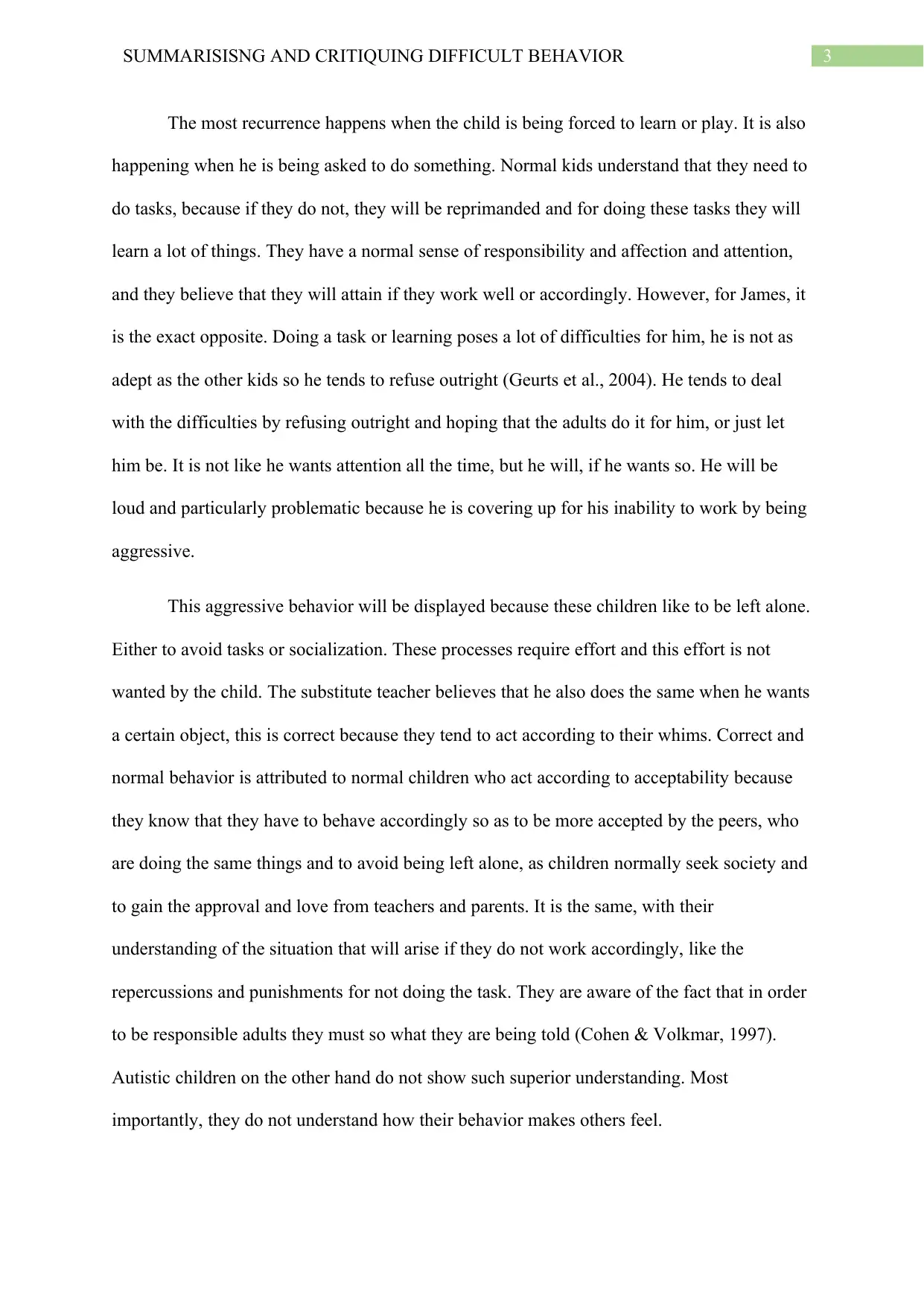
3SUMMARISISNG AND CRITIQUING DIFFICULT BEHAVIOR
The most recurrence happens when the child is being forced to learn or play. It is also
happening when he is being asked to do something. Normal kids understand that they need to
do tasks, because if they do not, they will be reprimanded and for doing these tasks they will
learn a lot of things. They have a normal sense of responsibility and affection and attention,
and they believe that they will attain if they work well or accordingly. However, for James, it
is the exact opposite. Doing a task or learning poses a lot of difficulties for him, he is not as
adept as the other kids so he tends to refuse outright (Geurts et al., 2004). He tends to deal
with the difficulties by refusing outright and hoping that the adults do it for him, or just let
him be. It is not like he wants attention all the time, but he will, if he wants so. He will be
loud and particularly problematic because he is covering up for his inability to work by being
aggressive.
This aggressive behavior will be displayed because these children like to be left alone.
Either to avoid tasks or socialization. These processes require effort and this effort is not
wanted by the child. The substitute teacher believes that he also does the same when he wants
a certain object, this is correct because they tend to act according to their whims. Correct and
normal behavior is attributed to normal children who act according to acceptability because
they know that they have to behave accordingly so as to be more accepted by the peers, who
are doing the same things and to avoid being left alone, as children normally seek society and
to gain the approval and love from teachers and parents. It is the same, with their
understanding of the situation that will arise if they do not work accordingly, like the
repercussions and punishments for not doing the task. They are aware of the fact that in order
to be responsible adults they must so what they are being told (Cohen & Volkmar, 1997).
Autistic children on the other hand do not show such superior understanding. Most
importantly, they do not understand how their behavior makes others feel.
The most recurrence happens when the child is being forced to learn or play. It is also
happening when he is being asked to do something. Normal kids understand that they need to
do tasks, because if they do not, they will be reprimanded and for doing these tasks they will
learn a lot of things. They have a normal sense of responsibility and affection and attention,
and they believe that they will attain if they work well or accordingly. However, for James, it
is the exact opposite. Doing a task or learning poses a lot of difficulties for him, he is not as
adept as the other kids so he tends to refuse outright (Geurts et al., 2004). He tends to deal
with the difficulties by refusing outright and hoping that the adults do it for him, or just let
him be. It is not like he wants attention all the time, but he will, if he wants so. He will be
loud and particularly problematic because he is covering up for his inability to work by being
aggressive.
This aggressive behavior will be displayed because these children like to be left alone.
Either to avoid tasks or socialization. These processes require effort and this effort is not
wanted by the child. The substitute teacher believes that he also does the same when he wants
a certain object, this is correct because they tend to act according to their whims. Correct and
normal behavior is attributed to normal children who act according to acceptability because
they know that they have to behave accordingly so as to be more accepted by the peers, who
are doing the same things and to avoid being left alone, as children normally seek society and
to gain the approval and love from teachers and parents. It is the same, with their
understanding of the situation that will arise if they do not work accordingly, like the
repercussions and punishments for not doing the task. They are aware of the fact that in order
to be responsible adults they must so what they are being told (Cohen & Volkmar, 1997).
Autistic children on the other hand do not show such superior understanding. Most
importantly, they do not understand how their behavior makes others feel.
Paraphrase This Document
Need a fresh take? Get an instant paraphrase of this document with our AI Paraphraser
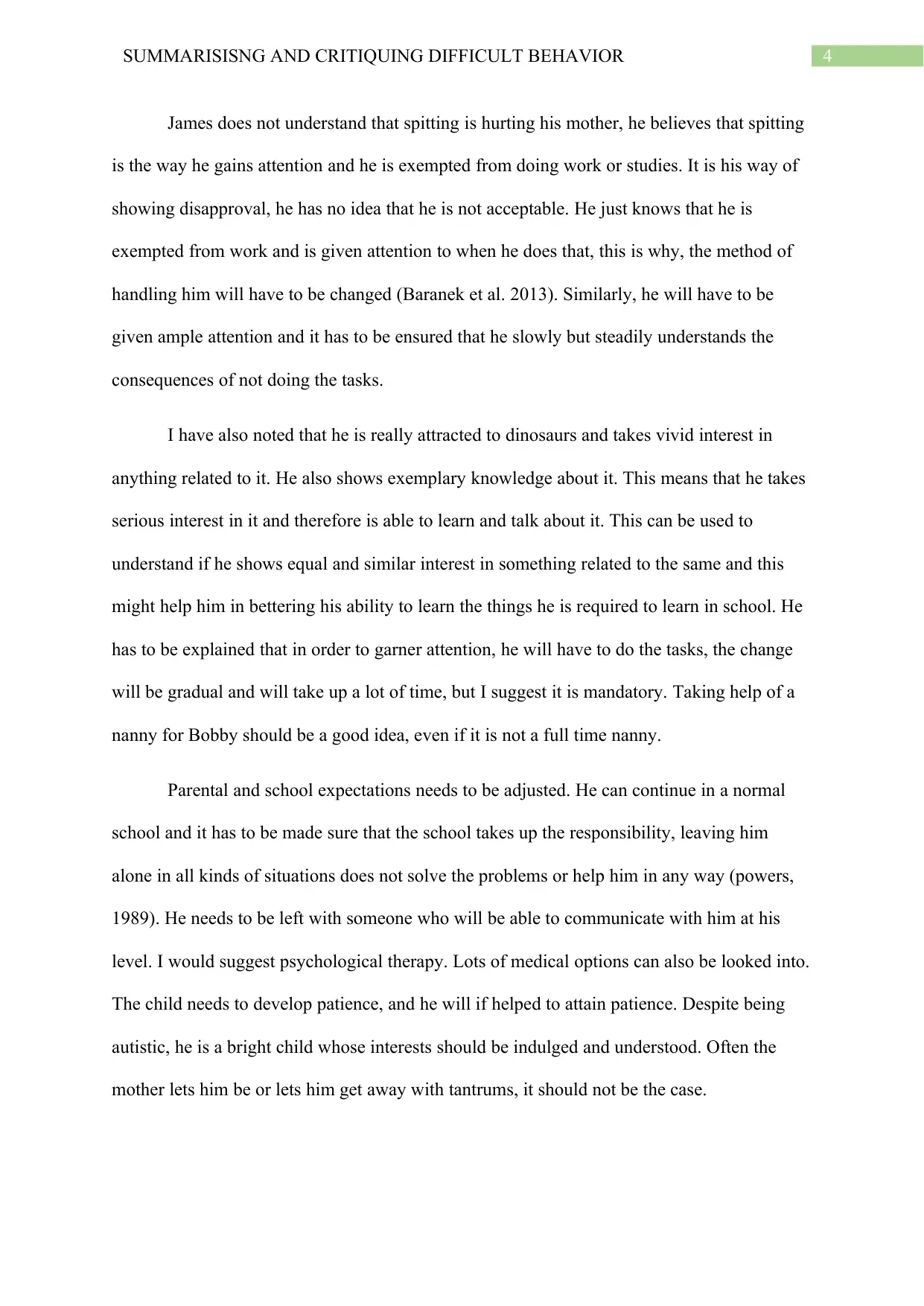
4SUMMARISISNG AND CRITIQUING DIFFICULT BEHAVIOR
James does not understand that spitting is hurting his mother, he believes that spitting
is the way he gains attention and he is exempted from doing work or studies. It is his way of
showing disapproval, he has no idea that he is not acceptable. He just knows that he is
exempted from work and is given attention to when he does that, this is why, the method of
handling him will have to be changed (Baranek et al. 2013). Similarly, he will have to be
given ample attention and it has to be ensured that he slowly but steadily understands the
consequences of not doing the tasks.
I have also noted that he is really attracted to dinosaurs and takes vivid interest in
anything related to it. He also shows exemplary knowledge about it. This means that he takes
serious interest in it and therefore is able to learn and talk about it. This can be used to
understand if he shows equal and similar interest in something related to the same and this
might help him in bettering his ability to learn the things he is required to learn in school. He
has to be explained that in order to garner attention, he will have to do the tasks, the change
will be gradual and will take up a lot of time, but I suggest it is mandatory. Taking help of a
nanny for Bobby should be a good idea, even if it is not a full time nanny.
Parental and school expectations needs to be adjusted. He can continue in a normal
school and it has to be made sure that the school takes up the responsibility, leaving him
alone in all kinds of situations does not solve the problems or help him in any way (powers,
1989). He needs to be left with someone who will be able to communicate with him at his
level. I would suggest psychological therapy. Lots of medical options can also be looked into.
The child needs to develop patience, and he will if helped to attain patience. Despite being
autistic, he is a bright child whose interests should be indulged and understood. Often the
mother lets him be or lets him get away with tantrums, it should not be the case.
James does not understand that spitting is hurting his mother, he believes that spitting
is the way he gains attention and he is exempted from doing work or studies. It is his way of
showing disapproval, he has no idea that he is not acceptable. He just knows that he is
exempted from work and is given attention to when he does that, this is why, the method of
handling him will have to be changed (Baranek et al. 2013). Similarly, he will have to be
given ample attention and it has to be ensured that he slowly but steadily understands the
consequences of not doing the tasks.
I have also noted that he is really attracted to dinosaurs and takes vivid interest in
anything related to it. He also shows exemplary knowledge about it. This means that he takes
serious interest in it and therefore is able to learn and talk about it. This can be used to
understand if he shows equal and similar interest in something related to the same and this
might help him in bettering his ability to learn the things he is required to learn in school. He
has to be explained that in order to garner attention, he will have to do the tasks, the change
will be gradual and will take up a lot of time, but I suggest it is mandatory. Taking help of a
nanny for Bobby should be a good idea, even if it is not a full time nanny.
Parental and school expectations needs to be adjusted. He can continue in a normal
school and it has to be made sure that the school takes up the responsibility, leaving him
alone in all kinds of situations does not solve the problems or help him in any way (powers,
1989). He needs to be left with someone who will be able to communicate with him at his
level. I would suggest psychological therapy. Lots of medical options can also be looked into.
The child needs to develop patience, and he will if helped to attain patience. Despite being
autistic, he is a bright child whose interests should be indulged and understood. Often the
mother lets him be or lets him get away with tantrums, it should not be the case.
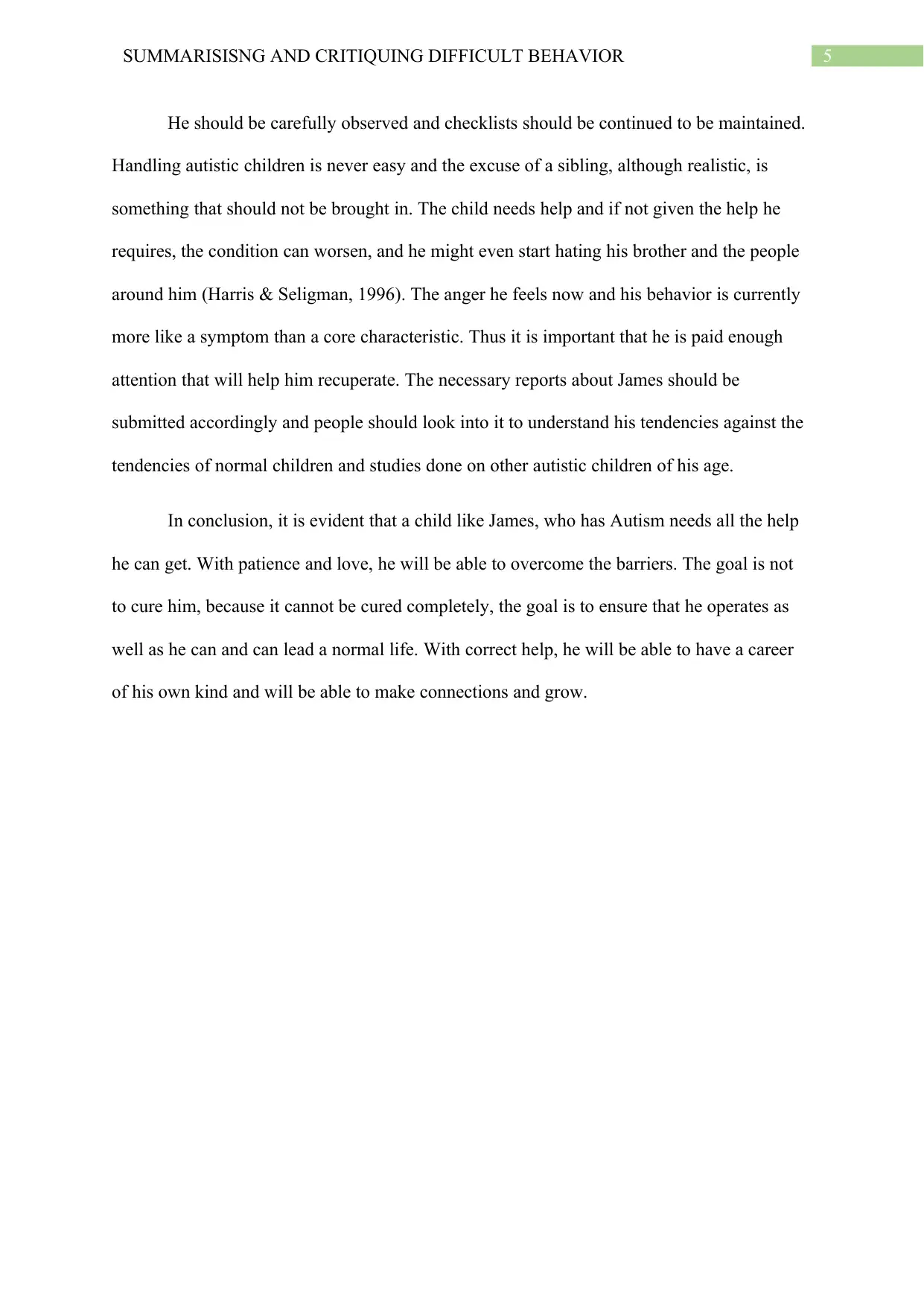
5SUMMARISISNG AND CRITIQUING DIFFICULT BEHAVIOR
He should be carefully observed and checklists should be continued to be maintained.
Handling autistic children is never easy and the excuse of a sibling, although realistic, is
something that should not be brought in. The child needs help and if not given the help he
requires, the condition can worsen, and he might even start hating his brother and the people
around him (Harris & Seligman, 1996). The anger he feels now and his behavior is currently
more like a symptom than a core characteristic. Thus it is important that he is paid enough
attention that will help him recuperate. The necessary reports about James should be
submitted accordingly and people should look into it to understand his tendencies against the
tendencies of normal children and studies done on other autistic children of his age.
In conclusion, it is evident that a child like James, who has Autism needs all the help
he can get. With patience and love, he will be able to overcome the barriers. The goal is not
to cure him, because it cannot be cured completely, the goal is to ensure that he operates as
well as he can and can lead a normal life. With correct help, he will be able to have a career
of his own kind and will be able to make connections and grow.
He should be carefully observed and checklists should be continued to be maintained.
Handling autistic children is never easy and the excuse of a sibling, although realistic, is
something that should not be brought in. The child needs help and if not given the help he
requires, the condition can worsen, and he might even start hating his brother and the people
around him (Harris & Seligman, 1996). The anger he feels now and his behavior is currently
more like a symptom than a core characteristic. Thus it is important that he is paid enough
attention that will help him recuperate. The necessary reports about James should be
submitted accordingly and people should look into it to understand his tendencies against the
tendencies of normal children and studies done on other autistic children of his age.
In conclusion, it is evident that a child like James, who has Autism needs all the help
he can get. With patience and love, he will be able to overcome the barriers. The goal is not
to cure him, because it cannot be cured completely, the goal is to ensure that he operates as
well as he can and can lead a normal life. With correct help, he will be able to have a career
of his own kind and will be able to make connections and grow.
⊘ This is a preview!⊘
Do you want full access?
Subscribe today to unlock all pages.

Trusted by 1+ million students worldwide
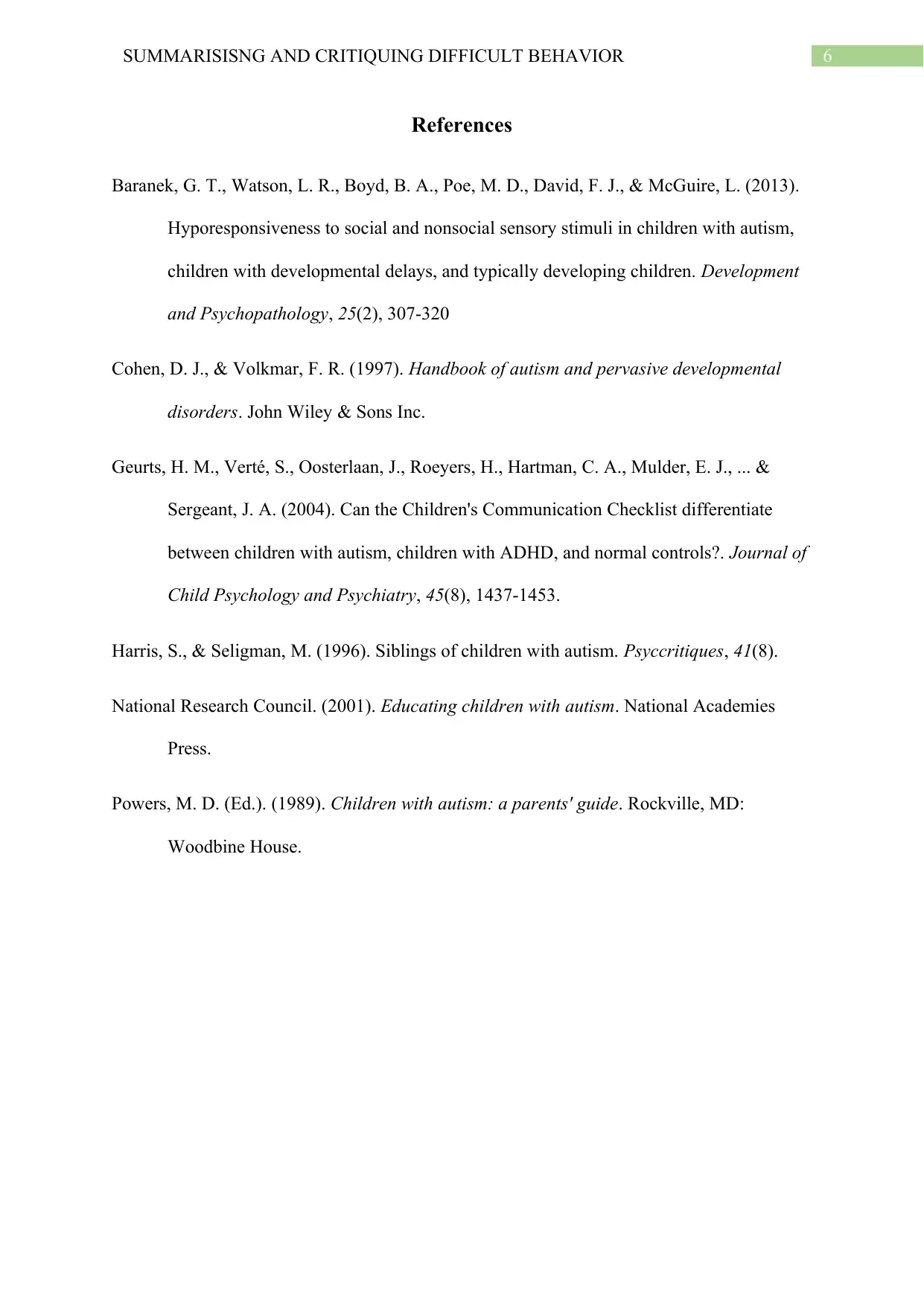
6SUMMARISISNG AND CRITIQUING DIFFICULT BEHAVIOR
References
Baranek, G. T., Watson, L. R., Boyd, B. A., Poe, M. D., David, F. J., & McGuire, L. (2013).
Hyporesponsiveness to social and nonsocial sensory stimuli in children with autism,
children with developmental delays, and typically developing children. Development
and Psychopathology, 25(2), 307-320
Cohen, D. J., & Volkmar, F. R. (1997). Handbook of autism and pervasive developmental
disorders. John Wiley & Sons Inc.
Geurts, H. M., Verté, S., Oosterlaan, J., Roeyers, H., Hartman, C. A., Mulder, E. J., ... &
Sergeant, J. A. (2004). Can the Children's Communication Checklist differentiate
between children with autism, children with ADHD, and normal controls?. Journal of
Child Psychology and Psychiatry, 45(8), 1437-1453.
Harris, S., & Seligman, M. (1996). Siblings of children with autism. Psyccritiques, 41(8).
National Research Council. (2001). Educating children with autism. National Academies
Press.
Powers, M. D. (Ed.). (1989). Children with autism: a parents' guide. Rockville, MD:
Woodbine House.
References
Baranek, G. T., Watson, L. R., Boyd, B. A., Poe, M. D., David, F. J., & McGuire, L. (2013).
Hyporesponsiveness to social and nonsocial sensory stimuli in children with autism,
children with developmental delays, and typically developing children. Development
and Psychopathology, 25(2), 307-320
Cohen, D. J., & Volkmar, F. R. (1997). Handbook of autism and pervasive developmental
disorders. John Wiley & Sons Inc.
Geurts, H. M., Verté, S., Oosterlaan, J., Roeyers, H., Hartman, C. A., Mulder, E. J., ... &
Sergeant, J. A. (2004). Can the Children's Communication Checklist differentiate
between children with autism, children with ADHD, and normal controls?. Journal of
Child Psychology and Psychiatry, 45(8), 1437-1453.
Harris, S., & Seligman, M. (1996). Siblings of children with autism. Psyccritiques, 41(8).
National Research Council. (2001). Educating children with autism. National Academies
Press.
Powers, M. D. (Ed.). (1989). Children with autism: a parents' guide. Rockville, MD:
Woodbine House.
1 out of 7
Related Documents
Your All-in-One AI-Powered Toolkit for Academic Success.
+13062052269
info@desklib.com
Available 24*7 on WhatsApp / Email
![[object Object]](/_next/static/media/star-bottom.7253800d.svg)
Unlock your academic potential
Copyright © 2020–2025 A2Z Services. All Rights Reserved. Developed and managed by ZUCOL.





